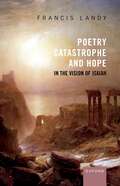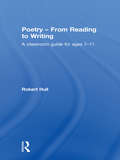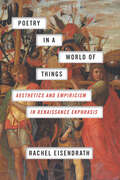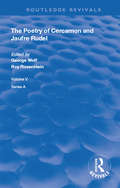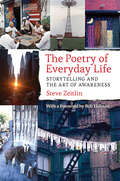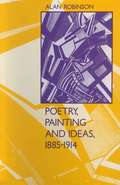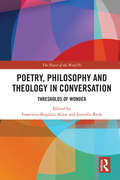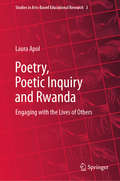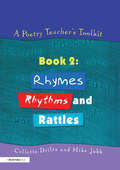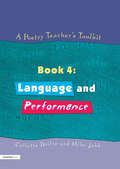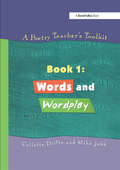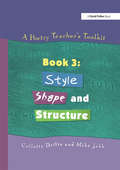- Table View
- List View
Poetry, Catastrophe, and Hope in the Vision of Isaiah
by Prof Francis LandyThe book of Isaiah is one of the longest and strangest books of the Hebrew Bible, composed over several centuries and traversing the catastrophe that befell the two kingdoms of Israel and Judah in the 8th and 6th centuries BCE. Francis Landy's book tells the story of the poetic response to catastrophe, and the hope for a new and perfect world on the other side. The study traces two parallel developments: the displacement of the Davidic promise onto the Persian Empire, Israel, and the prophet himself; and the transition from exclusively male images of the deity to the matching of male and female prototypes, whereby YHWH takes the place of the warrior goddess. Utopia, Catastrophe, and Poetry in the Book of Isaiah consists of close readings of individual passages in Isaiah, commencing with Chapter One and the problems of beginning, and ending with Deutero-Isaiah, composed subsequent to the Babylonian exile. The volume is arranged thematically as well as sequentially: the first chapter following the introduction concerns gender, the second death, the third the Oracles about the Nations. At the centre there is what Landy calls 'the constitutive enigma', Isaiah's commission in his vision to speak so that people will not understand. This renders the entire book potentially incomprehensible; the more we try to understand it, the greater the difficulty. For Landy, this creates a model of reading and writing, the challenge and the risk of going up blind alleys, of trying to make sense of a disastrous world. Isaiah's commission pervades the book. Throughout there is a promise of an age of clarity as well as social and political transformation, which is always deferred beyond the horizon. Hence it is a book without an ending, or with multiple endings. In the final chapters, the author turns to the central Chapter Thirty-Three, a mise-en-abyme of the book and a prayer for deliverance, and the issues of exile and the possibility of return. Like every poetic work, particularly in an era of cultural collapse, it is a critique of the past and a hope for a new humanity.
Poetry, Catastrophe, and Hope in the Vision of Isaiah
by Prof Francis LandyThe book of Isaiah is one of the longest and strangest books of the Hebrew Bible, composed over several centuries and traversing the catastrophe that befell the two kingdoms of Israel and Judah in the 8th and 6th centuries BCE. Francis Landy's book tells the story of the poetic response to catastrophe, and the hope for a new and perfect world on the other side. The study traces two parallel developments: the displacement of the Davidic promise onto the Persian Empire, Israel, and the prophet himself; and the transition from exclusively male images of the deity to the matching of male and female prototypes, whereby YHWH takes the place of the warrior goddess. Utopia, Catastrophe, and Poetry in the Book of Isaiah consists of close readings of individual passages in Isaiah, commencing with Chapter One and the problems of beginning, and ending with Deutero-Isaiah, composed subsequent to the Babylonian exile. The volume is arranged thematically as well as sequentially: the first chapter following the introduction concerns gender, the second death, the third the Oracles about the Nations. At the centre there is what Landy calls 'the constitutive enigma', Isaiah's commission in his vision to speak so that people will not understand. This renders the entire book potentially incomprehensible; the more we try to understand it, the greater the difficulty. For Landy, this creates a model of reading and writing, the challenge and the risk of going up blind alleys, of trying to make sense of a disastrous world. Isaiah's commission pervades the book. Throughout there is a promise of an age of clarity as well as social and political transformation, which is always deferred beyond the horizon. Hence it is a book without an ending, or with multiple endings. In the final chapters, the author turns to the central Chapter Thirty-Three, a mise-en-abyme of the book and a prayer for deliverance, and the issues of exile and the possibility of return. Like every poetic work, particularly in an era of cultural collapse, it is a critique of the past and a hope for a new humanity.
Poetry - From Reading to Writing: A Classroom Guide for Ages 7-11
by Robert HullPoetry – From Reading to Writing covers the process of writing poetry, from reading poems through to writing them. It is intended particularly for teachers at key stage 2 level, but other teachers will also find it valuable. It is clearly and accessibly written and jargon-free. In providing a wealth of practical ideas and activities preparing for the writing of poems, the book also stresses the use of talk, improvised drama and the reading and performance of poems. The author, who has published four collections of poetry, uses his own work and the work of others to explore how creative readings of poems can spark a child’s imagination and lead to original writing. Pupils are encouraged throughout the book to explore different forms of poetry, including: Rhyming and non-rhyming poems Riddles Short poems Haiku, tanka, renga Poems from stories Free verse Narrative poems Poems drawing on current affairs and history This book can be used by both pupils and teachers, and contains motivating tasks and tips to build pupils’ confidence in poetry writing. Explicit links are made throughout to the latest primary framework for literacy, making this an invaluable resource for all practising and trainee teachers who wish to teach poetry in the classroom in a creative and enjoyable way.
Poetry - From Reading to Writing: A Classroom Guide for Ages 7-11
by Robert HullPoetry – From Reading to Writing covers the process of writing poetry, from reading poems through to writing them. It is intended particularly for teachers at key stage 2 level, but other teachers will also find it valuable. It is clearly and accessibly written and jargon-free. In providing a wealth of practical ideas and activities preparing for the writing of poems, the book also stresses the use of talk, improvised drama and the reading and performance of poems. The author, who has published four collections of poetry, uses his own work and the work of others to explore how creative readings of poems can spark a child’s imagination and lead to original writing. Pupils are encouraged throughout the book to explore different forms of poetry, including: Rhyming and non-rhyming poems Riddles Short poems Haiku, tanka, renga Poems from stories Free verse Narrative poems Poems drawing on current affairs and history This book can be used by both pupils and teachers, and contains motivating tasks and tips to build pupils’ confidence in poetry writing. Explicit links are made throughout to the latest primary framework for literacy, making this an invaluable resource for all practising and trainee teachers who wish to teach poetry in the classroom in a creative and enjoyable way.
Poetry in a World of Things: Aesthetics and Empiricism in Renaissance Ekphrasis
by Rachel EisendrathWe have become used to looking at art from a stance of detachment. In order to be objective, we create a “mental space” between ourselves and the objects of our investigation, separating internal and external worlds. This detachment dates back to the early modern period, when researchers in a wide variety of fields tried to describe material objects as “things in themselves”—things, that is, without the admixture of imagination. Generations of scholars have heralded this shift as the Renaissance “discovery” of the observable world. In Poetry in a World of Things, Rachel Eisendrath explores how poetry responded to this new detachment by becoming a repository for a more complex experience of the world. The book focuses on ekphrasis, the elaborate literary description of a thing, as a mode of resistance to this new empirical objectivity. Poets like Petrarch, Spenser, Marlowe, and Shakespeare crafted highly artful descriptions that recovered the threatened subjective experience of the material world. In so doing, these poets reflected on the emergence of objectivity itself as a process that was often darker and more painful than otherwise acknowledged. This highly original book reclaims subjectivity as a decidedly poetic and human way of experiencing the material world and, at the same time, makes a case for understanding art objects as fundamentally unlike any other kind of objects.
Poetry in a World of Things: Aesthetics and Empiricism in Renaissance Ekphrasis
by Rachel EisendrathWe have become used to looking at art from a stance of detachment. In order to be objective, we create a “mental space” between ourselves and the objects of our investigation, separating internal and external worlds. This detachment dates back to the early modern period, when researchers in a wide variety of fields tried to describe material objects as “things in themselves”—things, that is, without the admixture of imagination. Generations of scholars have heralded this shift as the Renaissance “discovery” of the observable world. In Poetry in a World of Things, Rachel Eisendrath explores how poetry responded to this new detachment by becoming a repository for a more complex experience of the world. The book focuses on ekphrasis, the elaborate literary description of a thing, as a mode of resistance to this new empirical objectivity. Poets like Petrarch, Spenser, Marlowe, and Shakespeare crafted highly artful descriptions that recovered the threatened subjective experience of the material world. In so doing, these poets reflected on the emergence of objectivity itself as a process that was often darker and more painful than otherwise acknowledged. This highly original book reclaims subjectivity as a decidedly poetic and human way of experiencing the material world and, at the same time, makes a case for understanding art objects as fundamentally unlike any other kind of objects.
Poetry in a World of Things: Aesthetics and Empiricism in Renaissance Ekphrasis
by Rachel EisendrathWe have become used to looking at art from a stance of detachment. In order to be objective, we create a “mental space” between ourselves and the objects of our investigation, separating internal and external worlds. This detachment dates back to the early modern period, when researchers in a wide variety of fields tried to describe material objects as “things in themselves”—things, that is, without the admixture of imagination. Generations of scholars have heralded this shift as the Renaissance “discovery” of the observable world. In Poetry in a World of Things, Rachel Eisendrath explores how poetry responded to this new detachment by becoming a repository for a more complex experience of the world. The book focuses on ekphrasis, the elaborate literary description of a thing, as a mode of resistance to this new empirical objectivity. Poets like Petrarch, Spenser, Marlowe, and Shakespeare crafted highly artful descriptions that recovered the threatened subjective experience of the material world. In so doing, these poets reflected on the emergence of objectivity itself as a process that was often darker and more painful than otherwise acknowledged. This highly original book reclaims subjectivity as a decidedly poetic and human way of experiencing the material world and, at the same time, makes a case for understanding art objects as fundamentally unlike any other kind of objects.
Poetry in a World of Things: Aesthetics and Empiricism in Renaissance Ekphrasis
by Rachel EisendrathWe have become used to looking at art from a stance of detachment. In order to be objective, we create a “mental space” between ourselves and the objects of our investigation, separating internal and external worlds. This detachment dates back to the early modern period, when researchers in a wide variety of fields tried to describe material objects as “things in themselves”—things, that is, without the admixture of imagination. Generations of scholars have heralded this shift as the Renaissance “discovery” of the observable world. In Poetry in a World of Things, Rachel Eisendrath explores how poetry responded to this new detachment by becoming a repository for a more complex experience of the world. The book focuses on ekphrasis, the elaborate literary description of a thing, as a mode of resistance to this new empirical objectivity. Poets like Petrarch, Spenser, Marlowe, and Shakespeare crafted highly artful descriptions that recovered the threatened subjective experience of the material world. In so doing, these poets reflected on the emergence of objectivity itself as a process that was often darker and more painful than otherwise acknowledged. This highly original book reclaims subjectivity as a decidedly poetic and human way of experiencing the material world and, at the same time, makes a case for understanding art objects as fundamentally unlike any other kind of objects.
Poetry in a World of Things: Aesthetics and Empiricism in Renaissance Ekphrasis
by Rachel EisendrathWe have become used to looking at art from a stance of detachment. In order to be objective, we create a “mental space” between ourselves and the objects of our investigation, separating internal and external worlds. This detachment dates back to the early modern period, when researchers in a wide variety of fields tried to describe material objects as “things in themselves”—things, that is, without the admixture of imagination. Generations of scholars have heralded this shift as the Renaissance “discovery” of the observable world. In Poetry in a World of Things, Rachel Eisendrath explores how poetry responded to this new detachment by becoming a repository for a more complex experience of the world. The book focuses on ekphrasis, the elaborate literary description of a thing, as a mode of resistance to this new empirical objectivity. Poets like Petrarch, Spenser, Marlowe, and Shakespeare crafted highly artful descriptions that recovered the threatened subjective experience of the material world. In so doing, these poets reflected on the emergence of objectivity itself as a process that was often darker and more painful than otherwise acknowledged. This highly original book reclaims subjectivity as a decidedly poetic and human way of experiencing the material world and, at the same time, makes a case for understanding art objects as fundamentally unlike any other kind of objects.
Poetry in a World of Things: Aesthetics and Empiricism in Renaissance Ekphrasis
by Rachel EisendrathWe have become used to looking at art from a stance of detachment. In order to be objective, we create a “mental space” between ourselves and the objects of our investigation, separating internal and external worlds. This detachment dates back to the early modern period, when researchers in a wide variety of fields tried to describe material objects as “things in themselves”—things, that is, without the admixture of imagination. Generations of scholars have heralded this shift as the Renaissance “discovery” of the observable world. In Poetry in a World of Things, Rachel Eisendrath explores how poetry responded to this new detachment by becoming a repository for a more complex experience of the world. The book focuses on ekphrasis, the elaborate literary description of a thing, as a mode of resistance to this new empirical objectivity. Poets like Petrarch, Spenser, Marlowe, and Shakespeare crafted highly artful descriptions that recovered the threatened subjective experience of the material world. In so doing, these poets reflected on the emergence of objectivity itself as a process that was often darker and more painful than otherwise acknowledged. This highly original book reclaims subjectivity as a decidedly poetic and human way of experiencing the material world and, at the same time, makes a case for understanding art objects as fundamentally unlike any other kind of objects.
The Poetry of Cercamon and Jaufre Rudel (Routledge Revivals)
by George Wolf and Roy RosensteinPublished in 1983, Wolf and Rosenstein have delved into the poetry writings in detail of Cercamon and Jaufre Rudel, with detailed textual notes on the poems, exploring the individual poets' lives and looking at the translation of the writings.
The Poetry of Cercamon and Jaufre Rudel (Routledge Revivals)
by George Wolf Roy RosensteinPublished in 1983, Wolf and Rosenstein have delved into the poetry writings in detail of Cercamon and Jaufre Rudel, with detailed textual notes on the poems, exploring the individual poets' lives and looking at the translation of the writings.
The Poetry of Everyday Life: Storytelling and the Art of Awareness
by Steve ZeitlinThis is a book of encounters. Part memoir, part essay, and partly a guide to maximizing your capacity for fulfillment and expression, The Poetry of Everyday Life taps into the artistic side of what we often take for granted: the stories we tell, the people we love, the metaphors used by scientists, even our sex lives. A folklorist, writer, and cultural activist, Steve Zeitlin explores how poems serve us in daily life and how they are used in times of personal and national crisis. In the first book to bring together the perspectives of folklore and creative writing, Zeitlin explores meaning and experience, covering topics ranging from poetry in the life cycle to the contemporary uses of ancient myths. "This convergence of poetry and folklore," he suggests, "gives birth to something new: a new way of seeing ourselves, and a new way of being in the world." Written with humor and insight, the book introduces readers to the many eccentric and visionary characters Zeitlin has met in his career as a folklorist. Covering topics from Ping-Pong to cave paintings, from family poetry nights to delectable dishes at his favorite ethnic restaurants, The Poetry of Everyday Life will inspire readers to expand their consciousness of the beauty that resides in everyday things and to use creative expression to engage and animate that beauty toward living a more fulfilling awakened life, full of laughter. To live a creative life is the best way to engage with the beauty of the everyday.
Poetry, Philosophy and Theology in Conversation: Thresholds of Wonder: The Power of the Word IV
by Francesca Bugliani Knox Jennifer ReekThis volume is a collection of essays that explains how literature, philosophy and theology have explored the role of wonder in our lives, particularly through poetry. Wonder has been an object of fascination for these disciplines from the Greek antiquity onwards, yet the connections between their views on the subject are often ignored in subject specific studies. The book is divided into three parts: Part I opens the conversation on wonder in philosophy, Part II is given to theology and Part III to literary perspectives. An international set of contributors, including poets as well as scholars, have produced a study that looks beyond traditional chronological, geographical and disciplinary boundaries, both within the individual essays themselves and in respect to one another. The volume’s wide historical framework is punctuated by four poems by contemporary poets on the theme of wonder. An unconventional foray into one of the best-known themes of the European tradition, this book will be of great interest to scholars of literature, theology and philosophy.
Poetry, Philosophy and Theology in Conversation: Thresholds of Wonder: The Power of the Word IV
by Francesca Bugliani Knox Jennifer ReekThis volume is a collection of essays that explains how literature, philosophy and theology have explored the role of wonder in our lives, particularly through poetry. Wonder has been an object of fascination for these disciplines from the Greek antiquity onwards, yet the connections between their views on the subject are often ignored in subject specific studies. The book is divided into three parts: Part I opens the conversation on wonder in philosophy, Part II is given to theology and Part III to literary perspectives. An international set of contributors, including poets as well as scholars, have produced a study that looks beyond traditional chronological, geographical and disciplinary boundaries, both within the individual essays themselves and in respect to one another. The volume’s wide historical framework is punctuated by four poems by contemporary poets on the theme of wonder. An unconventional foray into one of the best-known themes of the European tradition, this book will be of great interest to scholars of literature, theology and philosophy.
Poetry, Poetic Inquiry and Rwanda: Engaging with the Lives of Others (Studies in Arts-Based Educational Research #3)
by Laura ApolThis book describes the practice of poetic inquiry and takes the reader through the process of translating lived experience into poetry that attends to the lives of others. Using her own writing—from early drafts to published poems—Apol demonstrates elements of poetic inquiry that both give it strength and make it complicated: the importance of craft (the aesthetic); the imperative of accuracy and reliability (the investigative); the significance of ethical responsibility that leads to action (witness); and the centrality of relational connectedness and accountability (withness). Apol raises questions about what it means for poems to function as both research and art, and illustrates what happens when there are irresolvable conflicts between the demands of the poem and a commitment to relationship. Throughout, Apol addresses her white privilege, as well as the dominant white/colonial narrative that often seeps into arts-based work unless it is overtly and critically addressed. The book goes beyond arts-based research, speaking as well to other forms of cross-national, cross-cultural research. It is a call for relational scholarship that moves toward action, a heart-rending teaching, a post-traumatic aesthetic map laid down with clear and poignant theory and praxis to extend, serve and guide.
A Poetry Teacher's Toolkit: Book 2: Rhymes, Rhythms and Rattles
by Collette Drifte Mike JubbProfessional poets spend many hours crafting a finished piece of work, yet we expect children in school to sit down and write when they are told to, whether they feel inspired or not. This series of four books is a toolkit to help you build a positive framework for children to read, write, understand and enjoy poetry - to bring a creative spark to the poetry classroom. A combination of featured poems, creative ideas, structured lesson plans and differentiated photocopiable activity sheets gives the series a uniquely flexible approach - which means you can use the materials in any classroom context. If you're wary of poetry, if you think it's boring, or if you're nervous about teaching poetry, then you've chosen the right book. Key themes covered in BOOK 2: Rhymes, Rhythms and Rattles are rhythm and rhyme in poetry, sounds, alliteration, words to create effects, onomatopoeia, and metaphor and simile. Other books in the series are: BOOK 1: Words and Wordplay; BOOK 3: Style, Shape and Structure; and BOOK 4: Language and Performance.
A Poetry Teacher's Toolkit: Book 4: Language and Performance
by Collette Drifte Mike JubbProfessional poets spend many hours crafting a finished piece of work, yet we expect children in school to sit down and write when they are told to, whether they feel inspired or not. This series of four books is a toolkit to help you build a positive framework for children to read, write, understand and enjoy poetry - to bring a creative spark to the poetry classroom. A combination of featured poems, creative ideas, structured lesson plans and differentiated photocopiable activity sheets gives the series a uniquely flexible approach - which means you can use the materials in any classroom context. If you're wary of poetry, if you think it's boring, or if you're nervous about teaching poetry, then you've chosen the right book. Key themes covered in BOOK 4: Language and Performance are moods and feelings through the use of effective language; nonsense and humorous verse; the continuity and links between ancient and modern, between nursery and playground rhymes and Shakespeare; whatever our ability, there is a place for everyone on the poetry 'ladder'; and performance poetry. Other books in the series are: BOOK 1: Words and Wordplay; BOOK 2: Rhymes, Rhythms and Rattles; and BOOK 3: Style, Shape and Structure.
A Poetry Teacher's Toolkit: Book 4: Language and Performance
by Collette Drifte Mike JubbProfessional poets spend many hours crafting a finished piece of work, yet we expect children in school to sit down and write when they are told to, whether they feel inspired or not. This series of four books is a toolkit to help you build a positive framework for children to read, write, understand and enjoy poetry - to bring a creative spark to the poetry classroom. A combination of featured poems, creative ideas, structured lesson plans and differentiated photocopiable activity sheets gives the series a uniquely flexible approach - which means you can use the materials in any classroom context. If you're wary of poetry, if you think it's boring, or if you're nervous about teaching poetry, then you've chosen the right book. Key themes covered in BOOK 4: Language and Performance are moods and feelings through the use of effective language; nonsense and humorous verse; the continuity and links between ancient and modern, between nursery and playground rhymes and Shakespeare; whatever our ability, there is a place for everyone on the poetry 'ladder'; and performance poetry. Other books in the series are: BOOK 1: Words and Wordplay; BOOK 2: Rhymes, Rhythms and Rattles; and BOOK 3: Style, Shape and Structure.
A Poetry Teacher's Toolkit: Book 2: Rhymes, Rhythms and Rattles
by Collette Drifte Mike JubbProfessional poets spend many hours crafting a finished piece of work, yet we expect children in school to sit down and write when they are told to, whether they feel inspired or not. This series of four books is a toolkit to help you build a positive framework for children to read, write, understand and enjoy poetry - to bring a creative spark to the poetry classroom. A combination of featured poems, creative ideas, structured lesson plans and differentiated photocopiable activity sheets gives the series a uniquely flexible approach - which means you can use the materials in any classroom context. If you're wary of poetry, if you think it's boring, or if you're nervous about teaching poetry, then you've chosen the right book. Key themes covered in BOOK 2: Rhymes, Rhythms and Rattles are rhythm and rhyme in poetry, sounds, alliteration, words to create effects, onomatopoeia, and metaphor and simile. Other books in the series are: BOOK 1: Words and Wordplay; BOOK 3: Style, Shape and Structure; and BOOK 4: Language and Performance.
A Poetry Teacher's Toolkit: Book 1: Words and Wordplay
by Collette Drifte Mike JubbProfessional poets spend many hours crafting a finished piece of work, yet we expect children in school to sit down and write when they are told to, whether they feel inspired or not. This series of four books is a toolkit to help you build a positive framework for children to read, write, understand and enjoy poetry - to bring a creative spark to the poetry classroom. A combination of featured poems, creative ideas, structured lesson plans and differentiated photocopiable activity sheets gives the series a uniquely flexible approach - which means you can use the materials in any classroom context. If you're wary of poetry, if you think it's boring, or if you're nervous about teaching poetry, then you've chosen the right book. Key themes covered in BOOK 1: Words and Wordplay are playing with words; making patterns with words; words and meanings; puns and puzzles; how words affect readers; moods, feelings and attitudes; and how poets manipulate words. Other books in the series are: BOOK 2: Rhymes, Rhythms and Rattles; BOOK 3: Style, Shape and Structure; and BOOK 4: Language and Performance.
A Poetry Teacher's Toolkit: Book 3: Style, Shape and Structure
by Collette Drifte Mike JubbProfessional poets spend many hours crafting a finished piece of work, yet we expect children in school to sit down and write when they are told to, whether they feel inspired or not. This series of four books is a toolkit to help you build a positive framework for children to read, write, understand and enjoy poetry - to bring a creative spark to the poetry classroom. A combination of featured poems, creative ideas, structured lesson plans and differentiated photocopiable activity sheets gives the series a uniquely flexible approach - which means you can use the materials in any classroom context. If you're wary of poetry, if you think it's boring, or if you're nervous about teaching poetry, then you've chosen the right book. Key themes covered in BOOK 3: Style, Shape and Structure are style and structure, addressing regular and standard forms, the impact of layout, free form, 'found' poetry, and concrete poetry. Other books in the series are: BOOK 1: Words and Wordplay; BOOK 2: Rhymes, Rhythms and Rattles; and BOOK 4: Language and Performance.
A Poetry Teacher's Toolkit: Book 1: Words and Wordplay
by Collette Drifte Mike JubbProfessional poets spend many hours crafting a finished piece of work, yet we expect children in school to sit down and write when they are told to, whether they feel inspired or not. This series of four books is a toolkit to help you build a positive framework for children to read, write, understand and enjoy poetry - to bring a creative spark to the poetry classroom. A combination of featured poems, creative ideas, structured lesson plans and differentiated photocopiable activity sheets gives the series a uniquely flexible approach - which means you can use the materials in any classroom context. If you're wary of poetry, if you think it's boring, or if you're nervous about teaching poetry, then you've chosen the right book. Key themes covered in BOOK 1: Words and Wordplay are playing with words; making patterns with words; words and meanings; puns and puzzles; how words affect readers; moods, feelings and attitudes; and how poets manipulate words. Other books in the series are: BOOK 2: Rhymes, Rhythms and Rattles; BOOK 3: Style, Shape and Structure; and BOOK 4: Language and Performance.
A Poetry Teacher's Toolkit: Book 3: Style, Shape and Structure
by Collette Drifte Mike JubbProfessional poets spend many hours crafting a finished piece of work, yet we expect children in school to sit down and write when they are told to, whether they feel inspired or not. This series of four books is a toolkit to help you build a positive framework for children to read, write, understand and enjoy poetry - to bring a creative spark to the poetry classroom. A combination of featured poems, creative ideas, structured lesson plans and differentiated photocopiable activity sheets gives the series a uniquely flexible approach - which means you can use the materials in any classroom context. If you're wary of poetry, if you think it's boring, or if you're nervous about teaching poetry, then you've chosen the right book. Key themes covered in BOOK 3: Style, Shape and Structure are style and structure, addressing regular and standard forms, the impact of layout, free form, 'found' poetry, and concrete poetry. Other books in the series are: BOOK 1: Words and Wordplay; BOOK 2: Rhymes, Rhythms and Rattles; and BOOK 4: Language and Performance.
